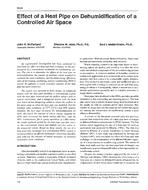At Fort Polk, Louisiana, the space conditioning systems of an entire city (4,003 military family housing units) have been converted to geothermal heat pumps (GHPs) under an energy savings performance contract. At the same time, other efficiency measures, such as compact fluorescent lights, low-flow hot water outlets, and attic insulation, were installed. Pre- and post-retrofit data were taken at 15-minute intervals on energy flows through the electrical distribution feeders that serve the family housing areas of the post. Fifteen-minute-interval data were also taken on energy use from a sample of the residences. The analysis presented shows that for a typical meteorological year, the retrofits result in electrical energy savings of approximately 25.6 million kWh, or 32.4% of the pre-retrofit electrical use in family housing. Peak electrical demand has also been reduced by about 6.8 MW, which is 40% of pre-retrofit peak demand. In addition, the retrofits save about 260,000 therms per year of natural gas. It should be noted that the energy savings presented are the “apparent” energy savings observed in the monitored data and are not to be mistaken for the “contracted” energy savings used as the basis for payments. To determine the “contracted” energy savings, the “apparent” energy savings may require adjustments for such things as changes in indoor temperature performance criteria, additions of ceiling fans, and other factors.
Units: I-P
KEYWORDS: year 1997, Electricity consumption, energy conservation, energy consumption, geothermal energy, heat pumps, performance, modernising, peak load, measuring, military works, housing, case studies
Citation: Symposium, ASHRAE Transactions, Vol.103, Part 2, Boston 1997
Product Details
- Published:
- 1997
- Number of Pages:
- 15
- File Size:
- 1 file , 1.7 MB
- Product Code(s):
- D-16710


